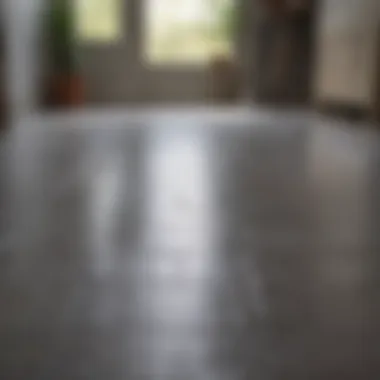Understanding Kitchen Floor Tiling Costs


Intro
When it comes to transforming a kitchen, the floor often sets the stage for the entire space. Tiling a kitchen floor isn't just about aesthetics; it's a financial commitment that needs careful consideration. Homeowners frequently underestimate the costs involved, thinking that the price of tiles is where the expenses end. However, various factors contribute to the total cost of tiling.
This article aims to break down the myriad of elements that shape the cost of tiling a kitchen floor. By understanding everything from the type of tiles available to labor and installation, you’ll be equipped with the knowledge to budget effectively and make informed selections. Whether you crave a sleek modern look or a rustic charm, this guide will illuminate the path to a stylish and enduring kitchen floor. It’s not just about laying tiles; it’s about building a space that enhances your home’s value and invites those you love to gather around.
"Good design is obvious. Great design is transparent." – Joe Sparano
Tiling can impact the overall feel of your kitchen, making the choice of tile and its installation all the more significant. Next, we’ll explore the Design Inspiration, examining the emerging trends and color schemes that could inspire your culinary retreat.
Understanding Tiling Basics
When considering a kitchen remodel, many homeowners find themselves entangled in the nuances of flooring options. Among these, tiling stands out as both an aesthetic choice and a practical solution. Understanding the basic premises of tiling not only eases the decision-making process but also arms you with the knowledge to navigate the often-tumultuous sea of opinions and advice.
Tiling is not merely about selecting a pretty surface; it involves assessing the unique needs of your kitchen environment. From durability to slip-resistance, tile choices play a significant role in the functionality of your space. Skimming the surface may leave you vulnerable to future regrets.
What Is Floor Tiling?
In simple terms, floor tiling involves laying flat, thin pieces of material— tiles— over a surface to create a finished flooring look. These tiles can be made from various materials, like ceramic, porcelain, or even natural stone. Each type boasts its own unique set of benefits and drawbacks. For instance, while ceramic is generally more affordable and easier to handle, porcelain tends to be denser and more resilient. Many people equate floor tiling with creativity. You can mix patterns and colors to forge a uniquely personal aesthetic.
Tiles come in various shapes and sizes, ranging from classic square patterns to intricate mosaics. The installation process requires a certain level of precision, as tiles need to be evenly spaced and securely adhered to the subfloor. This typically involves a thin-set mortar or adhesive, carefully applying it to ensure no gaps that could lead to breakage over time. It’s a bit like putting together a puzzle, where every piece must fit just right.
Why Choose Tiles for Kitchens?
Opting for tiles in your kitchen might seem straightforward at first glance, but it’s a decision steeped in numerous benefits. First and foremost is the durability factor. Kitchen floors endure heavy foot traffic, spills, and the occasional mishap with a dropped plate. Tiles, particularly those made from porcelain or stone, can withstand the test of time under such pressures.
Another key aspect is ease of maintenance. Compared to hardwood or carpet, tiles require much less upkeep. A quick mop or sweep usually does the trick, while most stains aren’t too hard to tackle. This can save a good chunk of time, especially in a bustling household.
Finally, it would be remiss not to mention the vast array of design options. From classic marble looks to funky geometric designs, tiles can cater to nearly any aesthetic preference. There’s something almost hypnotic about watching an entire kitchen transform from bland to bold just through the thoughtful use of tiles. When planned wisely, they not only elevate the visual appeal but also harmonize with your home's overall style.
"A tile floor can be a work of art, a practical solution, and a reflection of your personality all in one."
In the broader scope of this article, knowing the basics of tiling serves as the bedrock on which the more technical discussions will rest. From material costs to installation considerations, understanding the what and why behind floor tiling informs the decisions you’ll inevitably need to make later on.
Types of Tiles and Their Costs
Understanding the various types of tiles and their costs is crucial when considering tiling a kitchen floor. Each type of tile comes with its own set of benefits and drawbacks, affecting your overall budget and long-term satisfaction with your choice. Choosing the right tile can mean the difference between a stylish, functional kitchen and one that requires constant upkeep or repairs. Below, we explore various options available for kitchen tiling, detailing what to expect in terms of pricing, durability, and aesthetic appeal.
Ceramic Tiles: An Affordable Option
Ceramic tiles are often the go-to choice for homeowners looking for a balance between cost and quality. Generally more affordable than other options, this tile type has a variety of patterns and colors, which makes it versatile for many kitchen designs. Their price range typically lies between $1 to $5 per square foot, making them quite accessible for budget-conscious renovators.
One notable advantage is their ease of installation, especially for those who might consider a DIY approach. However, it’s essential to remember that while they might be budget-friendly, they aren't as hard-wearing as some other types. This means that if your kitchen sees heavy foot traffic or if you have pets that dart around, you might need to consider options that offer more durability.
"When going for ceramic, consider the thickness and the finish; that can affect how well they wear over time!"
Porcelain Tiles: Durability at a Price
Moving up the cost ladder, porcelain tiles present a more robust alternative. They are often made from denser clay and fired at higher temperatures, granting them superior strength and low water absorption—ideal for kitchens where spills might occur. Expect to pay between $3 to $12 per square foot for these tiles.


Beyond sheer durability, porcelain tiles tend to be easier to maintain than their ceramic counterparts. With a simple wipe-down, they often shine like the day they were installed. However, while they are a sound investment, the initial cost may make some homeowners think twice. If your goal is longevity and style without sacrificing quality, this is a tile worth considering.
Natural Stone Tiles: Luxury and Expense
For those willing to splurge, natural stone tiles can add a touch of elegance that few other materials can match. Available varieties like granite, marble, and slate offer unique aesthetics that can elevate any kitchen design. However, this luxury comes at a price, often ranging from $5 to $30 per square foot, depending on the type of stone and its source.
Maintenance is a consideration when it comes to natural stone, as these tiles tend to be porous and may require sealing to avoid stains and degradation. Factoring in potential maintenance costs is crucial when planning a budget for natural stone—this isn’t just a one-time purchase. If you're someone who values uniqueness and character, natural stone might be the way to go, but be mindful of the long-term care it requires.
Glass Tiles: Aesthetic Appeal and Cost Factors
Glass tiles have gained popularity in recent years, thanks to their modern look and reflective properties that can brighten up any kitchen. Pricing for glass tiles can vary widely, ranging from about $7 to $25 per square foot. They are often used as accents or backsplashes instead of full floor coverage due to their higher cost and fragility.
While glass tiles can create stunning visual effects, their main drawback is that they can chip or break more easily than ceramic or porcelain tiles, making them less ideal for areas with heavy foot traffic. If you do choose to incorporate glass tiles into your design, do so thoughtfully—think of them more as a design statement than a workhorse.
Preparation Costs
When venturing into a tiling project, it’s wise to pause and assess the groundwork before laying down those tiles. Preparation costs often create the invisible financial framework that determines the success of your endeavor. Ignoring these aspects means risking complications down the line, so it’s crucial to fully understand what lies beneath the surface.
Assessing Your Current Floor
Before you get too far down the rabbit hole of picking out your dream tiles, take a good look at your current flooring. Is it in decent shape, or has it seen better days? Uneven surfaces can spell disaster for your tiling project. You might find that your existing floor doesn't provide the solid foundation required.
Consider the following steps for assessment:
- Check for levelness: Use a level tool to identify any dips or bumps.
- Look for damage: Cracks or water damage might need addressing first.
- Age matters: Older floors might have issues you can't see at first glance.
When you spot problems, it’s time to think about either fixing them or removing your current flooring altogether. This upfront assessment could save you a heap of trouble later on, not to mention costs.
Subfloor Requirements and Costs
Next up is considering your subfloor—a foundational layer that directly affects the longevity and stability of your tiles. If your subfloor is suffering from wear and tear, you may have to replace it entirely or at least invest in repairs. Keep in mind, the type of subfloor you have impacts the choices you can make going forward with your tile selection.
Costs might vary significantly based on materials:
- Plywood is a cost-effective choice but ensure it's water-resistant.
- Cement board offers durability, especially in moisture-prone areas like kitchens.
- Epoxy coatings can act as additional barriers but come at a higher price point.
Don’t forget to plan for the installation costs, which can add another layer to your budget concerns.
Removing Old Flooring: What to Expect
If you’ve decided to bid farewell to your current flooring, you’re probably in for a bit of a chore. Removing old flooring may sound straightforward, but it can come with its own set of surprises.
Be prepared for:
- Potential damage: The underlying floor might reveal issues like water damage or rot.
- Unexpected debris: Whether it's adhesive residues or uneven surfaces, clean up can take more time than you expect.
- Disposal fees: Getting rid of the old materials doesn’t come for free!
"Preparation paves the way for success; any hidden issues can derail your tiling plans before they even get off the ground."
Taking the time to thoroughly prepare can be more than worth it as you consider your complete budget. Ensure you've accounted for all these variables before diving into the exciting world of selecting the perfect tile.


Installation Costs
When it comes to tiling your kitchen floor, understanding installation costs is crucial. This phase involves more than just the price of labor; it encompasses the expertise, time, and effort needed to achieve a durable finish that looks polished. Getting a firm grip on these costs helps homeowners budget effectively, avoiding unexpected financial jabs down the road.
Hiring a Professional vs. DIY
Opting for professional installation can certainly lighten your workload. Professionals bring years of experience to the table, ensuring the job is done right the first time. This can save one from headaches like uneven tiles or improper grouting, which often leads to costly repairs later on.
However, for the intrepid DIYer, this can be a tempting challenge. With the right tools and resources, laying tiles yourself can be a fulfilling project. Just remember, the initial cost saved might not equal the potential pitfalls. If things go south, you may end up shelling out more cash to rectify those mistakes.
"An amateur can make a marvelous mess, but it usually comes with a hefty cleanup bill."
In considering your options, think about your skill level, the complexity of the tile layout, and how valuable your time is. If you’re keen on the DIY route, perhaps take a local workshop first, or watch some tutorial videos online.
Labor Rates: What to Anticipate
Labor costs vary significantly depending on various factors such as location, the complexity of the job, and the installer’s experience. Generally, homeowners might expect to pay between $2 to $6 per square foot for labor. In metro areas, this can soar higher.
It's important to get a few quotes, as this can help gauge the market rates. Also, consider if the contractor includes additional services like prep work or cleanup, which could be a hidden cost not immediately visible in the quotes.
Make sure to clarify if these rates apply on the weekend or during holidays, as many pros charge extra for those days. Having a clear discussion about this can prevent any surprises when the bill arrives.
Tools Required for Installation
If you decide to take the plunge and install tiles yourself, equipping yourself with the right tools is essential. Here's a short rundown of what you might need:
- Tile Cutter: To ensure clean cuts for each tile.
- Trowels: Necessary for applying adhesive smoothly on the floor.
- Level: To make sure everything is even; a tilted tile can ruin the look.
- Grout Float: Helps to fill in those empty spaces effectively.
- Spacers: To keep the tiles uniformly spaced.
- Kneepads: Trust me, your knees will thank you later.
Investing in quality tools might seem steep, but borrowing or renting can be a viable option for those only needing them once. A well-equipped toolbox can really make the difference between a frustrating install and a smooth experience.
Understanding these facets of installation costs can prepare homeowners for the realities of a tiling project and ensure they aren't caught off-guard. Each decision made at this stage can significantly influence the project's overall budget and success.
Ongoing Maintenance Costs
When it comes to tiling a kitchen floor, it isn’t just the initial installation costs that merit attention. Ongoing maintenance costs play a crucial role in the long-term investment of your flooring solution. Many homeowners might overlook this, but proper upkeep can safeguard your tiles and subsequently influence the overall durability and appearance of your kitchen. By recognizing these costs, you can ensure that your kitchen remains not just functional but also visually appealing over time.
Cleaning and Upkeep of Tiles
Cleaning tiles might sound simple, but it’s a bit of an art form that requires consistency and the right approach. Regular maintenance involves sweeping or vacuuming to remove dirt and debris, which can scratch the surface if left unattended. For deep cleaning, a pH-neutral tile cleaner is a wise choice. This helps prevent any potential damage while ensuring the tiles shine.
Additionally, certain types of tiles require sealants to maintain their finish. Natural stone, for instance, can absorb spills if not properly sealed, leading to stains. Therefore, applying a quality sealant every year or so is often advisable. Here are some benefits of consistent cleaning and upkeep:
- Prevents staining and dullness
- Extends lifespan of the tiles
- Keeps your kitchen looking fresh and inviting
However, be mindful of the cleaning products you choose. Some aggressive chemicals may harm the tiles over time. Opt for gentle solutions and maintain a regular cleaning schedule to preserve the tiles’ beauty and integrity.
Repairing Cracks and Chips
Eventually, wear and tear or heavy items dropping can lead to cracks and chips in your tiles. While this seems inevitable, knowing how to handle these issues proficiently can make a world of difference.


For minor chips, there are epoxy fillers designed specifically for tile repair. This option can minimize costs and save you from needing to replace the entire tile. On the flip side, deeper cracks might require more extensive work. Depending on the size and nature of the damage, you might need to replace the entire tile. This can escalate costs, but leaving the crack unfixed may worsen over time, leading to more significant issues.
Here’s a recommended approach for addressing tile damage:
- Assess the Damage: Determine if it’s a minor chip or a more significant crack.
- Clean the Area: Before attempting any repairs, ensure the area is free of dust or grime.
- Use Appropriate Repair Kit: Utilize tile repair kits available in the marketplace for small damages.
- Consult a Professional: For larger issues, consulting with a tile expert might save future expenses.
Keeping your tiles in good condition not only enhances your kitchen aesthetics but also retains its value, meaning you might recoup more upon selling your home.
Budgeting for Your Tiling Project
When it comes to tiling your kitchen floor, budgeting plays a crucial role in ensuring a successful renovation. A well-thought-out budget not only guides your financial decisions but also helps in preventing overspending. It’s easy to get drawn into the allure of high-end tiles or advanced installation techniques, but without a clear budget, you might find yourself hitting a financial wall.
Estimating Total Costs
Estimating the total costs of your tiling project is like trying to piece together a jigsaw puzzle; every aspect needs to fit just right. Several elements contribute to the overall expense, including:
- Tile Selection: Different types of tiles vary significantly in price. As discussed earlier, ceramic tiles are generally more affordable compared to porcelain or natural stones. Knowing your preferences and aligning them with your budget is key.
- Floor Area: Consider the square footage of the area you’re tiling. Larger spaces will naturally require more tiles, and thereby increase the overall cost.
- Preparation Work: Don’t forget to account for any prep work needed, such as leveling the floor or replacing the subfloor.
- Installation Labor: Whether hiring a professional or considering DIY, labor costs can add up quickly. Always include these in your estimates.
Getting a ballpark figure can be done by multiplying the cost per square foot of your chosen tiles with the total area, then adding installation and prep costs. For example, if you’re using tiles that cost $3 per square foot for a 200 square foot kitchen, it would be $600 for tiles alone. Add about $400 for labor and about $200 for preparation, totaling around $1200.
"A penny saved is a penny earned." Knowing where your money is going can save you from unnecessary stress down the line.
Finding Discounts and Deals
Finding discounts and deals is like striking gold in your tiling project. There’s a treasure trove of options out there if you look closely. Here are a few strategies:
- Local Tile Stores and Home Improvement Centers: Many local shops offer sales, especially during the off-season or around holidays.
- Online Wholesalers: Explore websites that specialize in bulk tile sales. Sometimes, purchasing online can save you a notable chunk of change.
- Tile Auctions: Participate in local auctions or estate sales. You can sometimes find quality tiles at a fraction of the retail price.
- Social Media and Community Boards: Check platforms like Reddit or Facebook Marketplace. People often sell leftover tiles from their own projects.
Ensuring that you secure coupons and stay informed about sales can lead you to find that perfect tile without breaking the bank. It pays to keep your ears to the ground and be ready when a good opportunity arises.
In summation, budgeting for your tiling project involves not only careful calculations but also a keen eye for deals. Every dollar saved can be put to better use—whether it’s upgrading your tile selection or investing in quality installation. Ultimately, a successful kitchen remodel is a carefully balanced act between expense and aesthetic appeal.
Maximizing Your Investment
When it comes to tiling your kitchen floor, maximizing your investment is a crucial consideration. The kitchen is often viewed as the heart of the home, where countless memories are made. Thus, investing wisely in materials and design can yield significant long-term rewards. Understanding how to make the most of your tiling project can help not only in improving aesthetics but also in enhancing property value.
One of the first elements to consider is the choice of tile. Opting for timeless designs can transcend trends, reducing the likelihood of needing another renovation soon. For instance, classic neutral tones in ceramic or porcelain tiles can blend seamlessly with various kitchen styles. Not only does this appeal to different tastes, but it also ensures your investment stands the test of time.
Moreover, consider durability. High-quality tiles can withstand the wear and tear of a bustling kitchen and resist damage from spills and heavy foot traffic. Investing in materials that last minimizes replacement costs and hassle in the future. Additionally, maintenance costs should be factored in. Some tiles require more frequent care, which can add up over time. Choosing a material with lower upkeep needs can offer savings and peace of mind.
Choosing Timeless Designs
Timeless designs are key to ensuring your kitchen remains stylish for years to come. Colors and patterns that don’t age quickly can significantly enhance your kitchen’s overall look. For example, opting for a simple herringbone pattern in neutral shades can add character without feeling outdated.
Furthermore, lighter colors can make a space feel bigger and brighter, while darker tones can add drama and warmth. A careful mix of these shades can create a balanced atmosphere.
When selecting a design, the goal is to think beyond current trends. While marble or glossy tiles may be popular now, they might not retain their appeal over time. Instead, consider classic styles such as subway tiles or natural stone that effortlessly fit in both modern and traditional settings.
"Choosing classic designs today means you'll thank yourself later when you're not facing a remodel within a couple of years."
Future-Proofing Your Kitchen
Future-proofing your kitchen means making choices that won’t just satisfy today’s needs but will also adapt to potential changes. Consider the functionality of your space and how you use it. As lifestyles change, so too can kitchen needs. For example, if you foresee a growing family or a shift in your cooking habits, selecting tiles that can endure various uses becomes essential.
It's also worth contemplating connectivity in your kitchen arrangement. What might seem perfect now could prove less suitable in a few years. Creating a versatile layout can often mean that your tiles need to be able to harmonize with new appliances or decor.
Investigate eco-friendly materials. Sustainable options are not only great for the environment but also cater to a growing market of conscious consumers, potentially boosting your property value. Consider how these attributes align with today’s values and what might resonate in the future. Strategically planning with eco-friendly elements in mind can also reflect well when you choose to sell.



